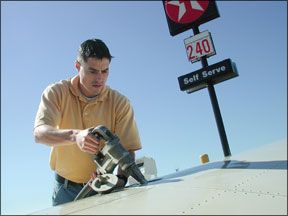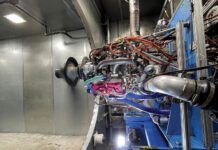As general aviation moves bumpily along toward a replacement fuel for 100LL, there’s a backlash brewing. Why, ask the owners of low-compression, low-output engines, do we have to settle on a single fuel? Why cant there be two unleaded fuels, a less expensive one for some users and a high-octane version for the rest? And why cant one of those fuels be mogas, which enjoyed wide popularity during the 1980s? Two-fuel systems are in place throughout western Europe, although not every airport has dual fueling. Some-usually smaller grass and club fields-have only one fuel available, while others have a 91/96 (the equivalent of 94UL) and conventional 100LL. A handful even have three fuels, since mogas has a tiny presence in Europe. But even that is becoming problematical as ethanol finds its way into the European fuel supply chain. In the U.S., resistance to a two-fuel approach centers on the distribution and refining system. Although the specifications exist for lower-octane unleaded fuels (94UL was recently approved) and the ASTM is actually considering at least one other aviation low-octane possibility, these arent seen as being viable for the U.S. market.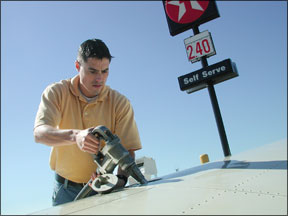
Wheres the Demand?
Although owners of aircraft capable of burning 94UL or its variants are beginning to make their voices heard, neither the oil companies nor the FBOs who sell the fuel are convinced there’s enough demand to make the effort worthwhile. We recently interviewed more than a dozen FBOs and flightschools to seek their opinions on installing two-fuel systems and we asked readers to tell us about their experiences with mogas as a second fuel.
Bottom line? While FBOs hardly dismiss the interest in mogas or a second fuel out of hand, theyre generally either not interested or not in a position to invest in the tankage necessary to dispense a second fuel.
“Look, this is a business,” says Ken Nierenberg, who runs a busy airport and flightschool in Prince-ton, New Jersey. “Im not going to put in another fuel tank, put up the money and not have the turnover that a gas station does. The money aint there.” Princeton moves a lot of avgas-about $20,000 in sales a month-and like most operators we talked to, Nierenberg sees investing in additional tanks as just splitting the same volume for less margin. In his view, the business case is weak.
But what about the build-it-and-they-will-come proposition? That, in fact, does work at some airports, although the return on investment may not be there.
“Were selling mogas as more of a service to tenants than anything else,” says Scott Sheets, the FBO manager at Paige Field Aviation Center in Fort Myers, Florida. “We have some light sport aircraft on the field and we wanted to move forward with a product for them that we realized wouldnt be a revenue generator initially.” We heard from several other FBOs who offer mogas as a second fuel for the same reason: service and convenience first, profit second.
In any case, making a profit on mogas is difficult because there’s no headroom on the retail price. At Fort Myers, mogas actually retails for more than avgas does: $4.01 self-service, versus $3.75 for self-service 100LL. But not all airports can afford to sell mogas as a loss leader. “Weve had reasonable interest in mogas. We have sources for unleaded fuel,” said Kurt Winker at Mid-Valley Airpark in Las Lunas, New Mexico. “But we cant get it as cheaply as the premium is across the street at a gas station,” he adds. If the on-airport price goes pennies too high, mogas users will simply buy it elsewhere and bring it into the airport in five-gallon cans or truck-mounted tanks.
“You at least have to pay for your capital; you have pay for your card fees; you have to pay your insurance. All those things chip away at your margin,” Winker explains. With the right mix of traffic, relatively high demand for mogas and a ready supply, that works at some airports. But at many, it doesnt.
“Its hard to say yes to that, to mogas. If I got a grant for the tanks, Id be all
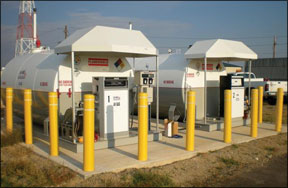
over it. If its going to come out of my pocket to justify it, I cant see that,” says Jason Hauck of Silverwing Flight service in Sandpoint, Idaho. Plus, he asks, what about an assured supply of mogas without ethanol added, so-called E0?
Supply Issues
And this is where the mogas question gets iffy. We asked Paige Aviation Centers Scott Sheets how confident he was of his mogas supply. “Not very,” was his blunt response. Although all of the mogas sellers and users we spoke to and corresponded with were enthusiastic about its potential, most of them had some version of this comment: “Im not sure I can continue to get this fuel.”
To illuminate this conundrum, we followed the supply chain up from the airports selling mogas to the distributors delivering it. This investigation revealed a curious disconnect. The major oil companies are essentially uninterested in developing a niche market for E0, at least for aircraft. One company, Marathon, whose suppliers market ethanol-free gas extensively in Florida, told us, “We are not interested in participating in this.” Was that selling mogas for airplanes or just answering questions about it? Both. A source inside a major oil company told us the company would actively seek to prevent E0 sales for aviation use because the fuels arent intended for that purpose. They see it as a liability issue.
Yet the market persists because there’s just enough E0 premium gas out there to sustain a tiny niche thats predominantly a local rather than a national market.
To soak up all the ethanol being produced, refiners deliver whats called blendstock for oxygenate blending or BOB. These fuels are specifically refined so that when ethanol is added, theyll hit the required octane numbers. Because ethanol is corrosive, it doesnt move through pipelines, but is blended with the BOB at the delivery terminal, just before being trucked to the retail outlets.
BOB is not a legal fuel because it doesnt meet any ASTM specs without the ethanol added, but this requirement varies by state. In 36 states, the E0 that distributors sell is supposed to be an ASTM-spec fuel, much of it as a 91-octane finished motor fuel meeting ASTM D-4814, sometimes called “regularly constituted gasoline.” But we see other grades as well.
It appears that most of this gasoline is marketed by small, specialty refineries and is available as a niche product in some markets, but not in others. In any case, aviation represents a tiny slice of the demand, with agriculture, marine and recreational uses representing a greater volume.
Its unclear to us if these companies will stay in this market, but the downstream suppliers we spoke to told us theyre committed to the E0 market as long as regulators don’t eliminate it as an option. “It really depends on what the government does,” says Sherry Lenz, director of operations at Hicks Oil in Avon Park, Florida, which supplies several airports in Florida, including Fort Myers.
Speaking of the government, as we go press, Congress was debating whether to extend the 45-cent per gallon blender credit for ethanol, a $6 billion federal program. The credit was due to expire at the end of December 2010 and although there’s sentiment in Congress to allow that to happen, two corn state senators
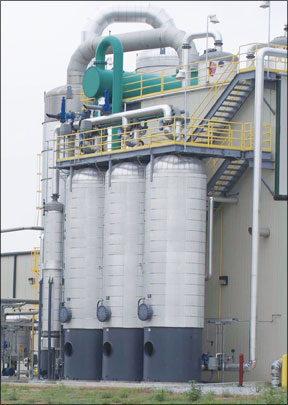
introduced an 11th-hour bill to lower the credit from 45 cents to 36 cents. But even if the credits end, the EPA still has in place Renewable Fuel Standard mandates that will require 12 billion gallons of ethanol to be blended into the U.S. gasoline supply in 2011.
Thats a lot of ethanol and refiners are already talking about hitting the “blend wall;” not enough gasoline to absorb all of that ethanol. So it seems unlikely that the amount of ethanol-blended gasoline were seeing in the retail fuel supply will decline. In fact, EPA recently approved E15 as an option. States are largely up to their own devices to regulate how ethanol is blended-some require it in all fuel while most allow exemptions for ethanol-free fuel in niche markets, such as marine, agriculture and aviation.
“It is entirely a market-driven niche,” says Florida Department of Agricultures Richard Kempsey.
We Like It
And what market niche that does exist for mogas in aviation loves the stuff. Despite the tiny fraction of airports that offer it, we heard from more than 100 owners using mogas. Obviously, the major driver is cost, but so is reduced maintenance.
“I fly a Lancair ES powered by a 350-HP fuel-injected Mazda Wankel engine. I had been using mogas with great results until the government mandated 10 percent ethanol in all auto fuels,” says Mark Steitle of Lockhart, Texas. “Avgas shortens plug life, fouls the O2 sensor, provides no benefit to the rotary engine and costs 33 percent more.”
We heard variations of Steitles story over and over again. Only a few of the owners we heard from have avgas available on the field, the rest roll their own supply.
“I have on-farm storage and I haul the mogas in myself. I always test the fuel that I am purchasing to make sure it does not contain ethanol. This fuel is used in several other vehicles as we’ll and in some farm equipment,” owner James Griffith told us. He doses each tank with an ounce of Marvel Mystery oil to keep valves from sticking, one thing that mogas users complain about. They also complain about vapor locking and sooty exhaust, but these are nits that don’t count against the overwhelming positives of using mogas instead of avgas. One owner stopped using mogas after an inflight stoppage due to vapor locking.
The largest complaint, next to the inability to find mogas, is the ethanol problem. But some owners just ignore that and burn the gas anyway. Ocean Air, a flightschool in California, runs E10 exclusively in its Rotax-powered Tecnams, hauling the gas in plastic cans since it isn’t available on the field. (The Tecnams and engines are approved for E10.) But even some owners whose airplanes arent approved for it still burn it.
“In the aircraft, the worst problem with E10 is operational, not mechanical. Ethanol blends take much longer to produce a clear sump sample due to their affinity for water. They continue to absorb water on the ground and in flight if the air is humid. Flights of longer than four hours can result in gascolators being completely full of water upon landing. Ive kept company with many 172 pilots over the last eight years who are using ethanol-blended fuels because they cant get pure gas in their states. They report the same results: Just be extra cautious when you sump the tanks, and there are no other adverse effects. This is with blends in the three to 10 percent range which appear in most northern states,” one reader told us. “So the concerns over vapor-locking and fuel system deterioration are largely unfounded. The prime concern will be water contamination and that can be properly managed.”
We should note that STCs for autogas specifically prohibit use of E10 and research done by Cessna and others reveals that it can cause corrosion, damage to seals and other maintenance issues. There is an effort to push the industry to retain the E0 niche. See www. pure-gas.org and www.e0pc.com. The former lists gas stations selling E0, the latter represents a grass roots effort to force Congress to reconsider mandates or assure that a non-ethanol premium can stand in the market, protected by state or federal exemptions.
Conclusion
Its unclear to us how robust the premium E0 market will be, facing as it does rising quotas for ethanol blending. Although its a high-margin product for refineries, its also very low volume with minimal demand. Doubling aviation and marine use wouldnt change the equation much.
From what were able to determine, the two-fuel approach works in Europe because the proportion of avgas usage is exactly the reverse of the U.S. pattern: Most of the volume-or at least an equal volme-is burned by aircraft requiring low-octane, while in the U.S. high-octane users account for most 100LL usage. The larger factor may be that in Europe, distribution is vertically organized. The gasoline supplier provides the tankage, not the FBO, making it painless for airports to carry both fuels. Thats a different model and one that U.S. FBOs might like.
“If the tanks magically appeared, it would be a different story. Otherwise, I doubt the city would go for another fuel,” says Kent Marshall, who manages the Suffolk, Virginia, airport, where mogas has been a popular fuel for years, but which moves only about a tenth of the avgas volume.
Although the blender credits may go away and the bloom is definitely off the ethanol rose, it seems unlikely that with excess ethanol capacity, the EPA will reduce the mandates for blending it, thus E0 premium will be under growing market pressure.
Numerous readers told us that once-reliable supplies have dried up because states have pressured refiners to use more ethanol. In some regions, ethanol-free gasoline may remain available, but its likely to be subject to the whims of local demand and state laws. In our view, thats not a trend that points to a sustainable two-fuel system for the entire GA fleet.

